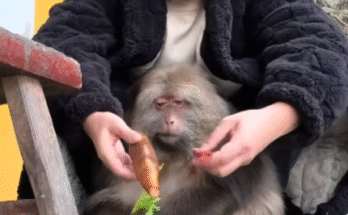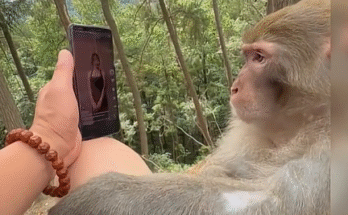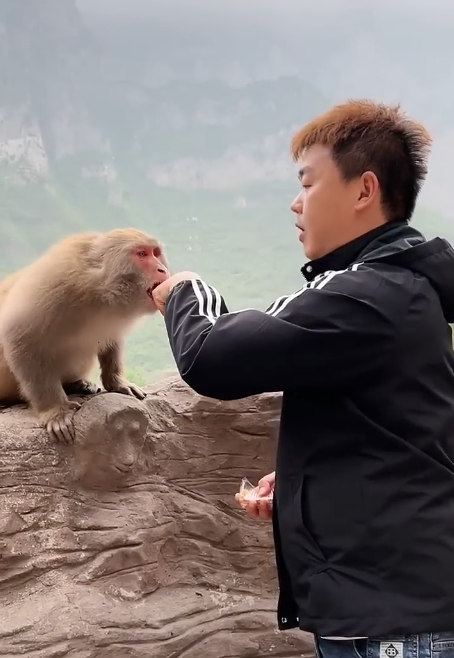
In a quiet corner of a sprawling monkey sanctuary, there lives a creature whose presence is as calming as the gentle rustle of leaves on a summer morning. Known among caretakers and fellow monkeys alike for his serene demeanor, this particular monkey has reached a level of grace and skill that seems almost otherworldly. Watching him move, it becomes clear that he is no ordinary monkey — he has become a spirit. But his abilities, though mesmerizing, are not to be imitated. The precision, strength, and wisdom behind his movements are gifts of nature, honed over years, and attempting them without his unique instincts could be perilous.
The day begins softly. Sunlight filters through the dense bamboo, painting golden streaks across the forest floor. Most monkeys awaken to a flurry of excitement, chasing one another, squealing, and diving into play. Not him. He rises slowly, stretching his limbs deliberately, his tail curling gracefully behind him, a picture of tranquility. Even the younger, more energetic monkeys pause to watch him, captivated by his calm aura.
His gentleness is not weakness. On the contrary, it is a form of mastery. He approaches each task and each interaction with careful thought and respect. When food is distributed, he takes only what he needs, allowing others to eat first. When playing with younger monkeys, he adjusts his strength to ensure no one is harmed, often guiding them gently rather than asserting dominance. There is an unspoken wisdom in his actions, a quiet command over both his environment and those around him.
Observers often comment on his movements. They are fluid, almost choreographed, yet entirely spontaneous. He can leap from branch to branch with the elegance of a dancer, balance on the thinnest ropes, and swing through trees without making a sound. Every motion is deliberate, executed with perfect timing, yet it carries the effortless grace of instinct. Watching him, one can understand why the locals sometimes refer to him as a spirit — a being who has transcended ordinary physical limitations while remaining entirely attuned to his surroundings.
Yet, with such extraordinary ability comes a cautionary note. Caretakers often remind visitors: do not imitate these moves. Attempting to replicate his leaps or acrobatics is dangerous. His body has adapted over years to manage extreme agility, balance, and reflexes. He senses the weight of each branch, the subtle shifts in wind, and the tension in every vine. A human, lacking his experience and anatomy, could easily fall or get injured. His spirit may appear playful and safe, but beneath that gentleness lies incredible power — a power that must be respected.
The monkey’s day is structured yet serene. Mornings are often devoted to observation and gentle exploration. He strolls along the higher branches, inspecting the environment, checking on younger monkeys, and ensuring harmony within the troop. There is an almost meditative quality to his movement, a rhythm that seems to flow naturally with the forest itself. The younger monkeys often mimic small gestures, like delicate hand placements or cautious steps along a branch, learning discipline from his calm example.
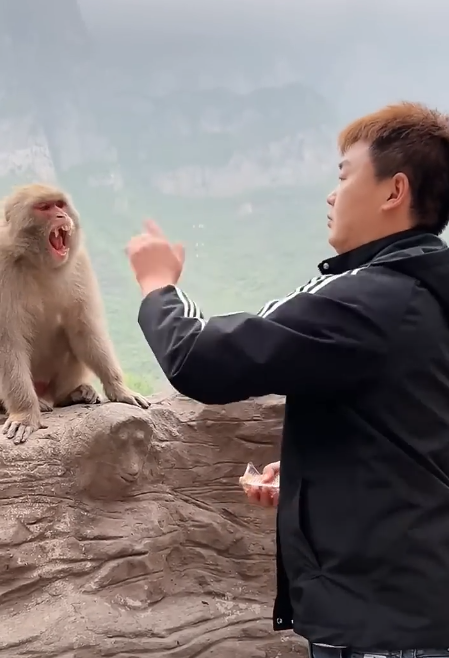
Mid-morning is typically feeding time. While other monkeys scramble and compete for food, he remains patient. He waits for the perfect moment, taking only what he can handle without disturbing the order of the troop. Occasionally, he shares a piece of fruit with a younger monkey or an injured companion. His actions demonstrate not just physical skill, but empathy and awareness. He has become a guide and a guardian, quietly ensuring the well-being of his community.
After feeding, he often engages in what appears to be play, but it is unlike the chaotic frolics of the other monkeys. His movements are precise, a mixture of exercise, skill-building, and demonstration. He jumps from ropes, swings on vines, and vaults over branches, all while maintaining absolute control over his balance. The younger monkeys watch in awe, learning that movement can be both graceful and purposeful. But again, observers are warned: this is not for imitation. Every move is calculated with instinctive knowledge that humans simply cannot replicate.
Despite his extraordinary agility, there is no aggression in his spirit. Even when challenged by other monkeys, he responds with subtle gestures rather than force. A slight shift of weight, a flick of the tail, or a gentle nudge is enough to resolve most conflicts. His presence commands respect, not fear. The troop instinctively recognizes his authority, responding with trust and cooperation. It is this blend of gentleness and power that elevates him beyond the ordinary — a true spirit of the forest.
As the day progresses, he takes moments to rest in elevated positions, basking in the sun or quietly observing the streams below. These periods of calm are not idle; they are moments of reflection, attunement, and energy conservation. Even in stillness, there is an aura of strength. His posture, gaze, and breathing all convey a deep connection with his environment. For visitors, it is a humbling sight — a reminder that mastery is not always loud or showy; sometimes it is the quiet presence that leaves the deepest impression.
Caretakers often introduce enrichment activities in the afternoon — puzzles, hidden treats, and obstacle courses designed to challenge the monkeys mentally and physically. While the other monkeys approach these challenges with urgency and noise, the gentle monkey handles them with patience and focus. He examines the obstacles, tests possibilities, and only acts when he is sure of the outcome. Watching him solve complex puzzles or navigate challenging terrain is mesmerizing. It is as if he has merged intellect with instinct, creating a level of competence that borders on the spiritual.
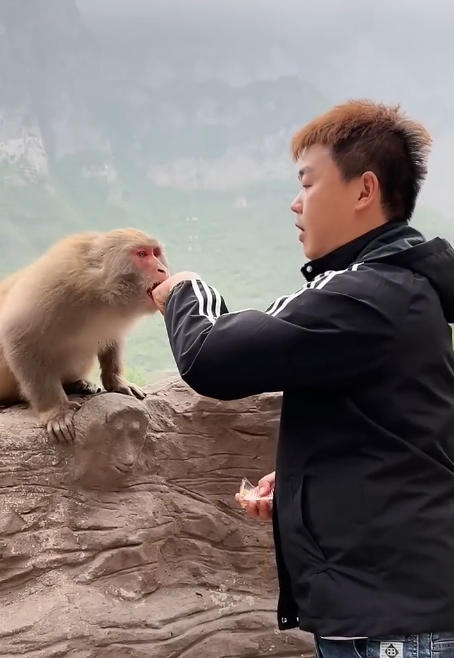
Evening brings a slower, reflective pace. The forest grows quiet, shadows stretch long across the ground, and the troop begins to settle. The gentle monkey moves among his companions, occasionally nudging a resting younger monkey or curling close to a partner in comfort. His day ends much as it began — with calm, gentle movements, blending seamlessly with the natural rhythm of the forest. The last rays of sunlight catch his golden-brown fur, highlighting the contours of his lithe body and the serene expression in his eyes.
Visitors often leave in awe, inspired by the combination of grace, intelligence, and empathy displayed by this extraordinary monkey. Yet the caretakers repeat the warning: do not imitate his moves. His spirit is a marvel to observe, but it is not a show or a stunt. Attempting his feats without the necessary physical attributes and instinctive knowledge can result in serious injury. The lesson is clear: respect, admiration, and observation are the ways to engage with such a spirit safely.
The gentle monkey has become more than an animal in the forest; he is a teacher, a guide, and a living symbol of the harmony between skill, intelligence, and compassion. Each movement carries a lesson, each glance conveys awareness, and each interaction demonstrates empathy. He embodies the idea that true strength does not require aggression or domination, but patience, precision, and care.
In the stillness of the night, when the forest quiets and only the sounds of rustling leaves and distant water remain, he settles into his favorite perch. Observers who remain until dusk notice the subtle twitch of his tail, a sign of continued awareness, even in rest. It is a final reminder that he is not just a monkey — he is a spirit. His presence transcends the ordinary, blending skill, gentleness, and wisdom into a living example of what it means to exist in harmony with one’s environment and community.
In conclusion, this gentle monkey demonstrates a rare combination of agility, intelligence, and compassion that elevates him to the level of a spirit. Observing him is a lesson in patience, respect, and careful attention to the natural world. His feats are mesmerizing, his demeanor calming, and his presence inspiring. But they are also a warning: the extraordinary skills of a spirit cannot safely be imitated. One must watch, learn, and admire from a distance.
This monkey reminds us that true mastery is not about spectacle or bravado. It is about harmony, control, and gentle strength. The spirit of this extraordinary creature lives on in the bamboo groves, in the quiet streams, and in the hearts of those lucky enough to witness his day. And as he moves through the sanctuary, tail flicking with effortless grace and eyes shining with intelligence, we are reminded that some beings are not meant to be imitated — they are meant to be revered, respected, and admired. 🐒✨

